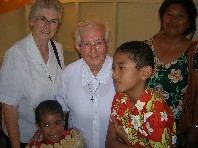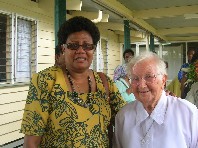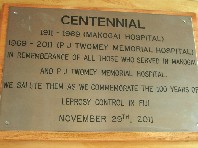06/11/2025
Needs of the Church, the Congregation and the world
06/11/2025
Prayer Intentions of the Pope
06/11/2025
Needs of the Church, the Congregation and the world
06/11/2025
Prayer Intentions of the Pope
04/09/2025
Needs of the Church, the Congregation and the world
04/09/2025
Needs of the Church, the Congregation and the world
04/09/2025
Prayer Intentions of the Pope






Archive: 2014 | 2013 | 2012 | 2011 | 2010 | 2009 | 2008 | 2007 | 2006
News inserted on 25/01/2012
 The Missionary Sisters of the Society of Mary (then the TORM) were asked to be responsible for the nursing care in Makogai. This island was purchased in 1908 by the Fiji government as a base for those suffering from Hansen’s disease, commonly known as leprosy. Sr Marie Stanislas and Sr Marie Suzanne, both from France, were appointed, together with two Fijian Sisters- Sr Filomena from Solevu and Sr Tekela from Rewa. (Their Congregation is now known as Sisters of Our Lady of Nazareth – SOLN). Sadly, the former contracted leprosy after fourteen years of dedicated service in Makogai. Their work would include visiting the villages for daily inspection, renewing dressings, listening to the patients’ troubles, consoling them, and sometimes it could include settling disputes.
The Missionary Sisters of the Society of Mary (then the TORM) were asked to be responsible for the nursing care in Makogai. This island was purchased in 1908 by the Fiji government as a base for those suffering from Hansen’s disease, commonly known as leprosy. Sr Marie Stanislas and Sr Marie Suzanne, both from France, were appointed, together with two Fijian Sisters- Sr Filomena from Solevu and Sr Tekela from Rewa. (Their Congregation is now known as Sisters of Our Lady of Nazareth – SOLN). Sadly, the former contracted leprosy after fourteen years of dedicated service in Makogai. Their work would include visiting the villages for daily inspection, renewing dressings, listening to the patients’ troubles, consoling them, and sometimes it could include settling disputes. In addition to the Sisters, there was a medical superintendent with overall responsibility, as well as 2 local medical practitioners, 6 Fijian wardens, 1 European warden, 20 indentured Indian labourers looking after the farm on the island and a mechanic. Dr Hall, an Irish Protestant, was the first doctor in residence followed by Dr Austin who spent 23 years on the island, and later by Dr Beckett.
In addition to the Sisters, there was a medical superintendent with overall responsibility, as well as 2 local medical practitioners, 6 Fijian wardens, 1 European warden, 20 indentured Indian labourers looking after the farm on the island and a mechanic. Dr Hall, an Irish Protestant, was the first doctor in residence followed by Dr Austin who spent 23 years on the island, and later by Dr Beckett. It was on 29 November 1911 that the first patients were admitted to Makogai and there was an annual intake after that. News of the care given at Makogai spread, so that in the 1920s there was an influx of patients from other islands of the Pacific.
It was on 29 November 1911 that the first patients were admitted to Makogai and there was an annual intake after that. News of the care given at Makogai spread, so that in the 1920s there was an influx of patients from other islands of the Pacific. To those diagnosed with leprosy in these early days, Makogai must have meant real desolation and despair - it was like a life sentence to isolation, separation from loved ones, loneliness, physical and moral suffering. The challenge was for the Sisters and the dedicated staff to transform this image. Hospital wards with clean beds were provided, villages, according to ethnic groupings, constructed for the more able-bodied, occupational therapy and recreation facilities established, schooling was offered to the children, clubs were formed, sports organised, scouts and girl guides set up and crafts and trades taught.
To those diagnosed with leprosy in these early days, Makogai must have meant real desolation and despair - it was like a life sentence to isolation, separation from loved ones, loneliness, physical and moral suffering. The challenge was for the Sisters and the dedicated staff to transform this image. Hospital wards with clean beds were provided, villages, according to ethnic groupings, constructed for the more able-bodied, occupational therapy and recreation facilities established, schooling was offered to the children, clubs were formed, sports organised, scouts and girl guides set up and crafts and trades taught.  Over the years Makogai welcomed many visitors. These included those for the patients, medical experts from all over the world, journalists, research workers, NZ governor generals, other VIPs including Queen Salote of Tonga¸ and later Leprosy Trust Board personnel.
Over the years Makogai welcomed many visitors. These included those for the patients, medical experts from all over the world, journalists, research workers, NZ governor generals, other VIPs including Queen Salote of Tonga¸ and later Leprosy Trust Board personnel.  On 29 November 2011, we celebrate the hundredth anniversary of the foundation of Makogai, which served as a leprosy hospital for 58 years, before the remaining patients were either repatriated or transferred to P. J. Twomey Hospital in Suva. We can thank God for all that was accomplished there through his grace, and for all those, especially our Sisters, who, in one way or another, shared in the ministry to the poor and the suffering of those who landed on Makogai shores.
On 29 November 2011, we celebrate the hundredth anniversary of the foundation of Makogai, which served as a leprosy hospital for 58 years, before the remaining patients were either repatriated or transferred to P. J. Twomey Hospital in Suva. We can thank God for all that was accomplished there through his grace, and for all those, especially our Sisters, who, in one way or another, shared in the ministry to the poor and the suffering of those who landed on Makogai shores.Archive: 2014 | 2013 | 2012 | 2011 | 2010 | 2009 | 2008 | 2007 | 2006